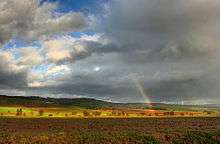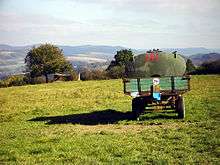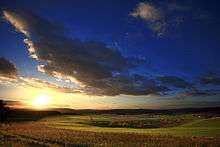Weser Uplands
The Weser Uplands[1] (German: Weserbergland) (German pronunciation: [ˈveːzɐˌbɛʁklant]) is a hill region (Bergland = uplands, hills or hill region) in Germany (Lower Saxony, Hesse, and North Rhine-Westphalia, between Hannoversch Münden and Porta Westfalica near the river Weser. Important cities of this region include Bad Karlshafen, Holzminden, Höxter, Bodenwerder, Hameln, Rinteln, and Vlotho. The tales of the Brothers Grimm are set in the Weser Uplands, and it has many renaissance buildings, exhibiting a peculiar regional style, the Weser Renaissance style. The region roughly coincides with the natural region of the Lower Saxon Hills defined by the Federal Agency for Nature Conservation or BfN.
Geography



In addition to the whole of the Weser Valley between Hann. Münden und Porta Westfalica, several geologically associated, but clearly separate chains of uplands, ridges and individual hills are considered part of the Weser Uplands. In its narrowest sense, the following would be included (running from north to south):
| Name | Height above NN |
|---|---|
| Weser Hills | 326.1 m |
| Süntel | 440 m |
| Ottenstein Plateau | 376 m |
| Vogler | 460.4 m |
| Burgberg | 357.5 m |
| Solling | 527.8 m |
| Reinhardswald | 472.2 m |
| Bramwald | 408 m |
The largest contiguous area of forest in the Weser Uplands lies on the Solling in the Solling-Vogler Nature Park. Its woods stretch southwards as far as the Reinardswald (on left bank of the Weser) and Bramwald (right bank), interrupted only by the island-like Uslar Basin and the narrow Weser valley. Even on the far side of the rivers Fulda and Werra - and thus beyond the Weser Uplands - the dense forest continues further south without significant interruption to the Kaufungen Forest.
Notable ridges
In addition to the aforementioned core ridges, other ranges and ridges are also sometimes considered part of the Weser Uplands. These mainly include the following (with maximum elevations given in metres above sea level (NN):
|
|
The last major changes to the landscape were made during the course of the ice ages by the glacial advances of the Scandinavian ice sheet which gave rise to much of Germany's present-day Northern Lowland.


Important towns
|
Culture
The Weser Uplands once developed its own style of architecture. Between 1520 and 1640 a great number of buildings were built in the so-called Weser Renaissance style.
Characters from the area who have achieved international renown include the legendary Pied Piper of Hamelin, the Lying Baron, Baron Munchausen, whose real-life inspiration came from Bodenwerder, and Doctor Eisenbarth who died in Hann. Münden.
In addition, many fairy tales by the Brothers Grimm were set in the region, for example, Snow White, which is supposed to have taken place in Alfeld, Rapunzel, who let down her long hair for her prince from a tower at Trendelburg Castle, or Sleeping Beauty, whose castle was based on the now ruined Sababurg near Hofgeismar.
Artistic reception
The picturesque landscape of the Weser Uplands has inspired many landscape painters and artists: Jacob Pins (1917–2005), Robert Batty, Christian Andreas Besemann, Carl Ferdinand Fabritius, Robert Geißler, Wolfgang Heinrich, Karl Arthur Held, Alfred Hesse, Rudolf Jahns, Herbert Mager, Anton Wilhelm Strack (1758–1829), Pascha Johann Friedrich Weitsch and August Wenderoth.
Tourism

The more significant tourist destinations in the region, in addition to the historic towns mentioned above are the Weser Uplands Schaumburg-Hamelin Nature Park, the Solling-Vogler Nature Park, the roughly 500 kilometre long distance cycle path, the Weser Cycleway along the River Weser. A botanic feature are the rare Dwarf Beech trees (Süntelbuchen).
Of increasing importance is motorcycle tourism. The Weser Uplands, like the Harz, is a popular motorcycle destination in northern Germany. In particular, the Köterberg, as the highest elevation from that point to the North Sea, is a popular motorcycle meeting point with a magnificent panoramic view up to 80 kilometres.
Other notable attractions are the Schillat Cave, the Tonenburg in Höxter-Albaxen, the Neuhaus Wildlife Park, the Weserstein in Hann. Münden and several museums such as the Agricultural Technology Museum in Börry, the hammer mill in Dassel, The German Huguenot Museum in Bad Karlshafen and the Motorcycle Museum in Wickensen.
Economy
The region is heavily influenced by tourism. Large areas are also utilized by agriculture and forestry and firms involved in processing the products of these industries, such as sawmills. A porcelain factory in Fürstenberg has been working since 1747.
References
- Dickinson, Robert E. (1964). Germany: A regional and economic geography (2nd ed.). London: Methuen. p. 37.
